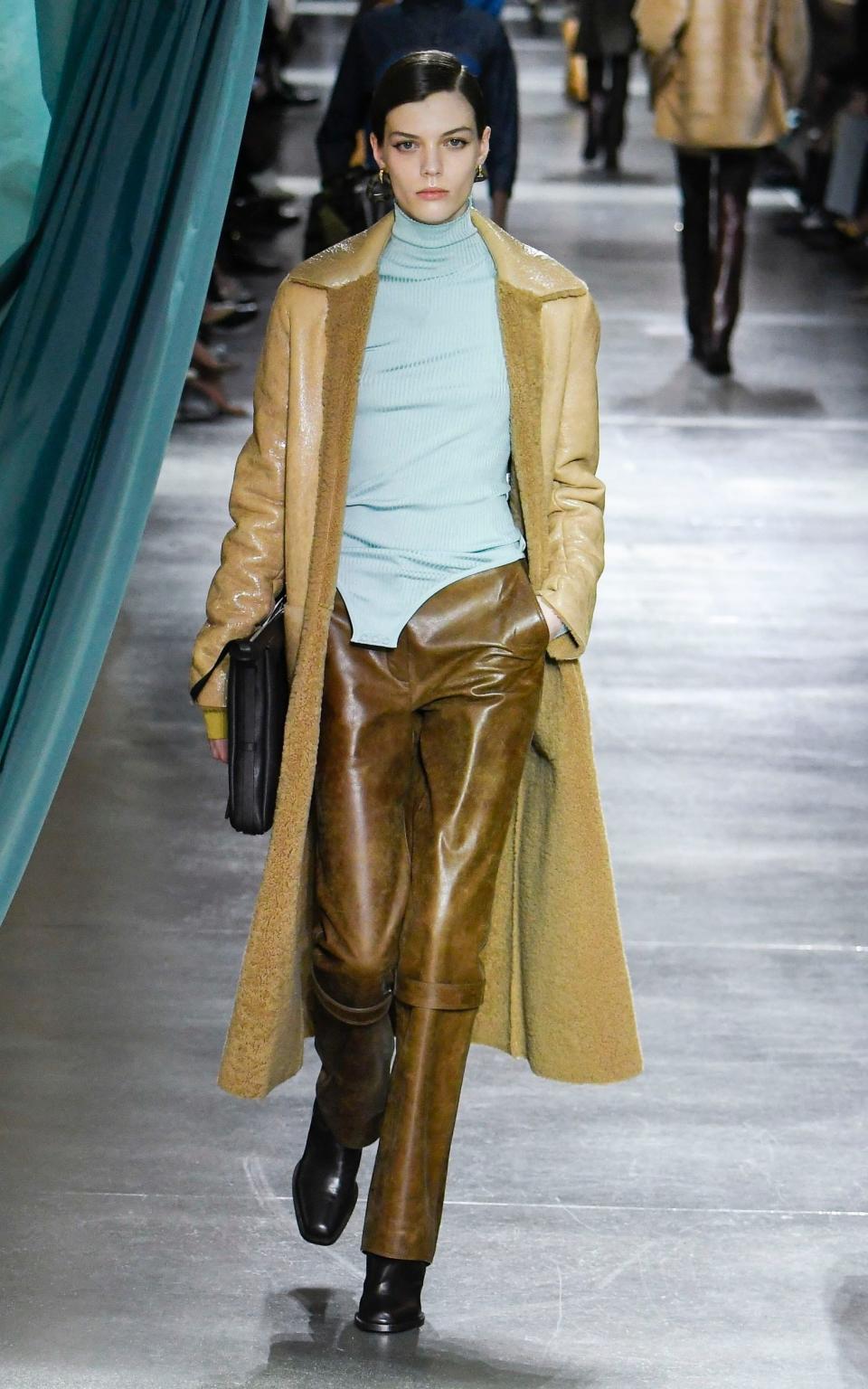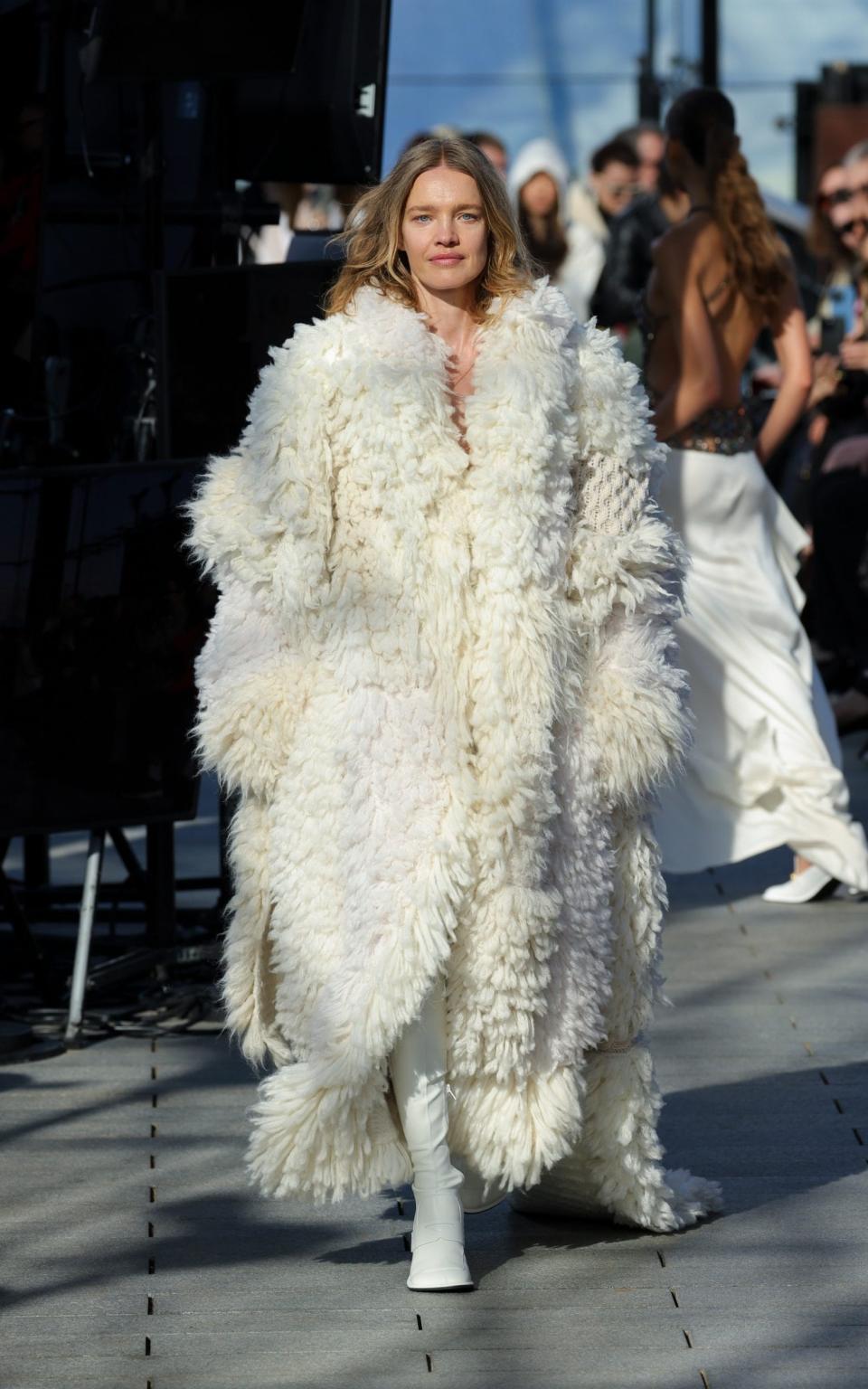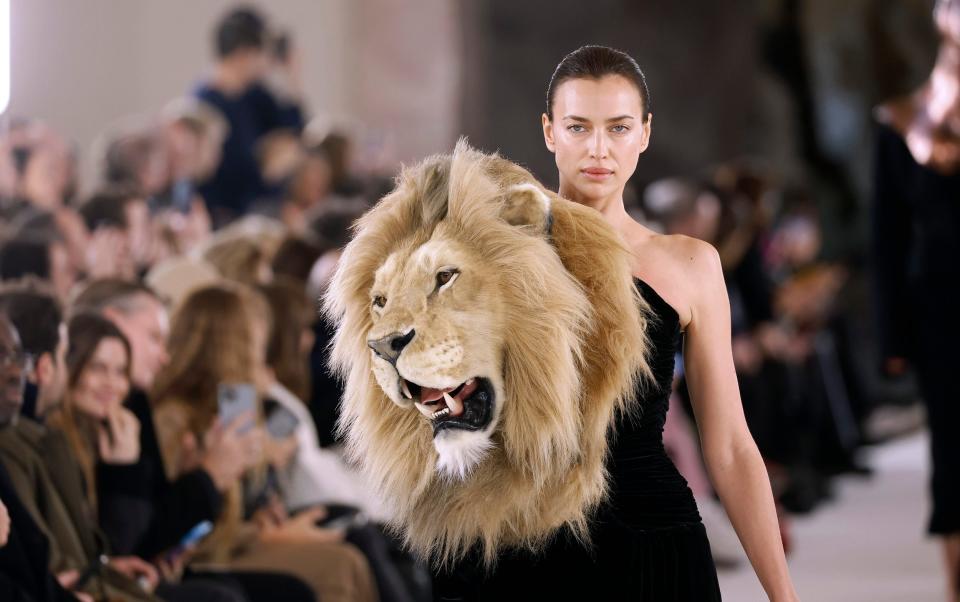The faux vs real fur debate has been reignited

From giant plush honey monster coats at Acne Studios and furry puffball coats at Celine to shaggy, ombre-dyed faux-fur jackets at Emporio Armani, not to mention the surprise return of the tippet at Prada (mood: A Touch of Fake Mink), all things tactile, shaggy, and (fake) furry are big news on the catwalks for winter 2024.
Many luxury brands have pivoted away from using real animal fur in recent years, of course, (LFW stopped showing animal fur in 2018, formalising the ban last year). Though at Fendi, where real animal pelts are still used, a PETA protester made their feelings known at the beginning of Milan Fashion Week, taking to the runway with a sign that read: “Animals are NOT clothing”.

“The history of fashion’s appropriation of animal skins, prints, and symbolism is also a history of society’s changing attitudes and ambivalences toward human-animal relations…” wrote super curator Andrew Bolton in his introduction to WILD: Fashion Untamed, an exhibition all about fur, at The Metropolitan Museum of Art in 2005, getting under the skin of the issue as per…I actually attended the opening gala of that show at the MET and can remember seeing a buyer for one of New York’s swishiest department stores dressed in a full-length strapless real fur gown.
It’s hard to imagine even the most attention-hogging of today’s red carpet habitués making such a confronting frock choice today; however, the politics – and wardrobe economics – of fur wearing are undergoing a shift.
Surprisingly, we are actually seeing a return to vintage real fur being worn, particularly by Gen Zs and the trend isn’t purely a fashion FROW phenomenon. I recently spotted a vintage fox fur bolero wearer among a gaggle of fellow sixth formers (otherwise dressed in de facto teen uniform of puffas and jeans), quite a standout on Hampstead High Street.
The current #mobwife trend on social media can be held at least partly responsible for driving the desire to wear old-school trophy furs, vintage, real, or not. (It is not without irony that actress Edie Falco, the actress who played Carmela Soprano, the ultimate #mobwife moodboard muse, is currently PETA’s Honorary Director campaigning against animal cruelty. And indeed there’s an argument that glorifying the whole #mobwife aesthetic allows the fur trade a free pass back to the mainstream and our high street stores).

However, for many new-gen vintage-fur wearers, the motivations are often more rooted in sustainability and a weariness with fashion brands’ greenwashing than mafia molls cosplay. “Unpopular Opinion: Vintage fur is more sustainable than faux fur” reads the caption on @collectivegoodshop (a Vintage Curator & Wardrobe Stylist Instagram account), one of many feeds that call out the environmental impact of faux fur, which tends to be derived from fossil fuels.
And, then there are the fiscal considerations that lie beneath the “new faux versus vintage real” debate (perhaps less blogged about, but an issue nonetheless): A slick faux fur bomber from YSL could put you back £7425 (composition 59% acrylic, 32% modacrylic, 9% polyester); whereas a cursory search on Vinted throws up a vintage 1950s real fur evening jacket, not as chic perhaps, but passable Grace Kelly vibes for a cool £50 (and more biodegradable to boot).
Iso Neville (26) is a second-hand stylist, whose look is more ’60s French starlet than mob wife (think vintage shearling ‘mini’-length car coat, worn with bare legs and tomboy boots, with Birkin-esque aplomb). “Anything in circulation is more sustainable than creating garments from new materials, whether those are faux or whether those are animal-based,” says Neville. “Obviously, it’s a very complex issue, because of potentially questionable practices around how that fur has been farmed… But actually faux fur is plastic and it doesn’t biodegrade, so I think it’s really greenwashing talking about faux fur as a sustainable alternative to real fur.”

Fashion journalist and thrift advisor Joséphine Giachero (24) tells me that she and several of her friends and peers wear vintage real fur “because they either inherited it as a hand-me-down, or they have managed to get one really nice piece”; but she is sensitive about the context and would not to wear it around friends who have strong feelings against fur.
“I would never show up in a vintage fur coat if I’m seeing them because I’m mindful that I have so many other things in my wardrobe.” Interestingly, the one fabric that Giachero tells me she would never wear – vintage or new – is faux. “It’s just so synthetic, it just gives me the ick…It has a lot to do with the sensorial experience not wanting to have that on my skin.”
The aesthetics and associations of fur (carnal or cruel) can provoke a powerful reaction, whether or not a pelt is real. I speak to Ruby Cohen (28), founder of life and death-style brand Café Mortel, who has spent years in and out of the vegan movement, who reminds me that Daniel Rosenberg’s faux taxidermy animal heads for Schiaparelli couture last year caused a media firestorm “and it was all fake, but people still were confronted and conflicted by it”.

I get in touch with plant-centric chef Bettina Campolucci Bordi (40, whose personal style I admire, as much as her delicious veggie food) to see how the idea of vintage fur sits with her sensibilities. Like many environmentally minded dressers, she is keenly focused on circularity and building a wardrobe of pieces that will last. “I would not wear vintage fur, I wouldn’t feel comfortable wearing it, however, I do have leather jackets. I’ve kept them and some of them are 20 years old, and I would like to hand those down to my daughter.”
For another stylish vegetarian friend (30) the choices are absolutely clear.” I wouldn’t wear fur, even if it was vintage, under any circumstance because it goes against everything I believe in. Even if it was given to me/handed down, I wouldn’t accept it because I love animals and I think they should be alive and happy, not used for fashion when there are so many great faux fur alternatives and other ways to keep warm!”
“Whether faux or real, I think it’s clear from recent collections that the fashion industry isn’t ready to let go of the aesthetic of fur, and what that brings to a look,” says sustainable fashion expert Chekii Harling (@trash4gold), 28. “My immediate reaction to seeing tons of faux fur on the runway is the same as when I’m looking at any designer’s collection that doesn’t feature the most sustainable materials possible.
“It could be an aesthetically beautiful collection with an amazing story behind it, but if they aren’t working with recycled, responsible, or innovative materials I don’t find it new or interesting…I’m fascinated by all the ways designers can work with waste and biomaterials; they are the fashion industry’s new innovators.”
“To halt climate change we need to both move away from fossil fuels and stop intensively farming cattle,” Harling continues, “I think what people shop is down to where their values lie.”
Personally speaking, I would find it hard to give up the lustre, the swagger and the larger-than-life silhouettes of the faux fur coats in my wardrobe. And, frankly, I always try to invest in faux for life: I have a particularly beloved electric blue Shrimps number that I bought in 2014 and have absolutely no intention of retiring any time soon.
Another interesting case in point is my vintage 1960s Royal Blizzard raincoat in a snow leopard print, which creates an optical illusion that, believe it or not, looks like fur (its beautiful embroidered label tells me it is made from Tergal: a wrinkle-resistant polyester that was popular in the 60s and 70s). This is a piece that I have relined at my local dry cleaners and it still garners compliments in what must be its seventh decade of use. So what are the resilient and climate-conscious fur alternatives of the future?

Nina Marenzi is the founder and director of The Sustainable Angle and Future Fabrics Expo (the environmentally friendly materials showcase coming to London, June 25-26). ‘‘There is much hope for next-gen materials where untapped waste streams from agricultural residues for example will be an important new feedstock for materials for fashion and packaging,”
Marenzi tells me. Marenzi’s names to look for include a flax material from CQ Studios, a London-based innovation studio, as well as BioFluff, the company responsible for Savian; an animal-free, plastic-free material used by Stella McCartney to create the non-fur fur coat that she presented at Cop28 (using 50 per cent agricultural waste streams no less).
Harling also points me in the direction of German-based producer Steiff Schulte “making fur-like materials using a blend of mohair & organic cotton and linen & organic cotton” (yes, that would be Steiff of the classic, old-fashioned toy bears… and a ray of hope that could bring a whole new level of meaning to the teddy bear coat!).
“In an ideal future, faux leather and faux fur would come from regenerative, plant-based sources, but the current reality is that many of these solutions aren’t being scaled,” admits Harling. “For this to happen there needs to be more demand and more investment from the industry at large into these brilliant innovations.”
For now, the faux versus real fur debate will certainly continue to rumble. Brash and superficial though it may seem, the #mobwife trend has certainly some brought some oxygen to the conversation, one that seems a little more nuanced and less polarised than perhaps it was in the ‘I’d rather go naked than wear fur’ ‘90s campaign era. After all, neither taboos nor greenwashing will save fashion, or the planet.
“Although I don’t support the production of new fur, I think vintage fur should be enjoyed. Wearing vintage fur that’s purchased locally is better for the planet than buying a new alternative, so I don’t think there should be so much shame around it,” says Harling.
“Shockingly, I discovered a few years ago that certain charity shops incinerate real fur that’s donated to them, so it’s worth checking what items charities do and don’t accept, and it could be better to donate unwanted items to local dealers or sell it online to make sure it finds a new home. I think incinerating fur is a step too far – it’s a disgrace to the animal that died for it.”

